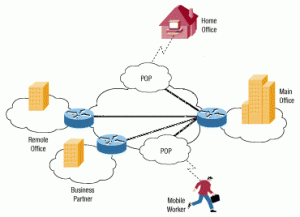 A virtual private network (VPN) is any type of private network that uses a public network to connect users and remote sites together. The public network that a VPN usually uses is of course, the Internet. Staying true to its name, a VPN uses virtual connections that route through the Internet to form a private network, such as a company or a home. These connections are then transferred to a remote location or an actual person (a user).
A virtual private network (VPN) is any type of private network that uses a public network to connect users and remote sites together. The public network that a VPN usually uses is of course, the Internet. Staying true to its name, a VPN uses virtual connections that route through the Internet to form a private network, such as a company or a home. These connections are then transferred to a remote location or an actual person (a user).
A wireless hotspot is a good example of a VPN. You go to a hotspot location and you use the public network of the Internet to get connection to your personal computer. If this transfer process wasn’t available, you wouldn’t be able to use your wireless access in a public coffee shop (or wherever your favorite hotspot is).
VPNs are also used a lot in large companies where everyone needs to be connected to the Internet all at one time. They make it easier for companies to set up a network where all of their employees can use the connection at the same time, without any hassle of dropped connections, etc.
A VPN can benefit everyone if it is well designed and planned out. There are some things that every VPN should have in order for it to work properly for everyone who uses it. It should definitely include security, reliability, scalability, network management and policy management. Without those protective utilities and guidelines, a VPN can just get out of control.
A VPN can also help by extending geographic connectivity, so you’re able to connect to the Internet from several different places and they also improve security within the connections. A huge benefit for large companies that use a VPN is that they cut down on costs quite a bit; both operational and time costs. VPNs also help improve productivity, they simplify network topology and provide telecommuter support, among other things.
Things can get a little complicated with the VPN setup, but they definitely are the way to go for large companies and smaller locations like WiFi hotspots, where several people will be using the Internet connection simultaneously.

KOMENTAR